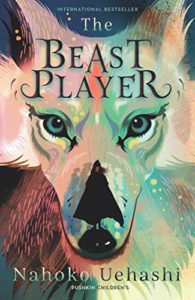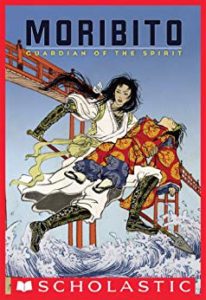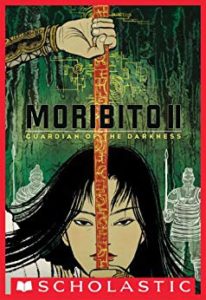
By Cathy Hirano
 Nahoko Uehashi is a prolific and well-loved Japanese author of fantasy as well as non-fiction. The list of awards she has won is impressive and includes the 2014 Hans Christian Andersen Literature Award, considered the Nobel Prize of children’s literature. During her writing career, which extends over three decades, she produced the 12-volume Moribito series, the 4-volume Beast Player series and The Deer King, a 2-volume epic encompassing more than 1,000 pages. Amazingly, through much of that period, she was also working as a full-time professor of cultural anthropology. Although most of her fantasies tend to be classified as children’s and young adult literature, a look at publisher surveys shows her readership spans all ages. Seventy percent of those who purchase her million-sellers range in age from their 30s into their 60s, with a particularly high concentration among women in their 30s and 40s. Her fan base includes elementary school students and seniors. While some adults are certainly buying the books for children, many are reading them for their own entertainment.
Nahoko Uehashi is a prolific and well-loved Japanese author of fantasy as well as non-fiction. The list of awards she has won is impressive and includes the 2014 Hans Christian Andersen Literature Award, considered the Nobel Prize of children’s literature. During her writing career, which extends over three decades, she produced the 12-volume Moribito series, the 4-volume Beast Player series and The Deer King, a 2-volume epic encompassing more than 1,000 pages. Amazingly, through much of that period, she was also working as a full-time professor of cultural anthropology. Although most of her fantasies tend to be classified as children’s and young adult literature, a look at publisher surveys shows her readership spans all ages. Seventy percent of those who purchase her million-sellers range in age from their 30s into their 60s, with a particularly high concentration among women in their 30s and 40s. Her fan base includes elementary school students and seniors. While some adults are certainly buying the books for children, many are reading them for their own entertainment.
Authors of contemporary Japanese fantasy, including Uehashi, were nurtured by a very rich body of translated (into Japanese) fantasy literature, including such classics as Lord of the Rings and the Narnia books. But Japan also has its own rich heritage of myths, folktales and literature on which to draw. Blending the real and the fantastic, these stories feature gods and goddesses, monster-vanquishing heroes, and strange, supernatural creatures known as yokai. This foundation is clearly reflected in manga and anime culture, which is now so popular in the West. Hayao Miyazaki’s Spirited Away, and such anime series as Naruto, Inuyasha and Yokai Watch are good examples. Uehashi herself attributes her lifelong love for stories to the folktales she heard at her grandmother’s knee as a child.
I think the broad appeal of Uehashi’s work lies in her ability to create worlds so authentic that they seem completely real. In addition, her complex and riveting plots, and believable characters are intriguing. Her exploration of universal themes, particularly the human fascination with “the other” lie at the bottom of much of her fantasy. As a translator and as someone living outside the culture in which I was raised, this theme of the other really resonates with me.
Her extensive knowledge and deep understanding of different cultures developed through her career as a cultural anthropologist gives her works a unique edge, enabling her to paint in rich detail not only the cultures, lifestyles and customs of the peoples she creates, but also their political systems, social values and religious beliefs. In fact, her descriptions of food are so enticing that a group of cooks got together to recreate the dishes described in all of her stories and published them as a cookbook.
At the same time, she leaves a lot to the imagination. For example, in The Beast Player, while the behavior of the Royal Beasts’ eating and mating habits are described in quite a bit of detail, their appearance is not. As a reader, this wasn’t a problem because I could picture them in my mind but when I went to translate the book, I found I didn’t know if they had four legs or two. And I had to look at the anime, for which Uehashi approved the portrayal, in order to make sure.
Uehashi’s works have influenced creators in other genres, such as in anime and film. She is collaborative in her approach and has an intense respect for, and understanding of, what it takes to translate a work into another language or medium. She is clear on what parts cannot be compromised in order to retain the integrity of the original work yet flexible on those parts that need to change to bridge the gap.
Other Popular Fantasy Authors
According to Otona no fantaji dokubon, a book that introduces fantasies published in Japan that can be enjoyed by adults as well as younger readers, the following authors (in addition to Uehashi) have had at least one of their fantasy works published in English: Noriko Ogiwara (Dragon Sword and Wind Child, Mirror Sword and Shadow Prince), Eiko Kadono (Kiki’s Delivery Service), winner of the 2018 Hans Christian Andersen Award, Miyuki Miyabe (Brave Story, The Book of Heroes), Fuyumi Ono (The Twelve Kingdoms series), Tomiko Inui (The Secret of the Blue Glass) and Naoko Awa (The Fox’s Window and Other Stories).
 However, Otona no fantaji dokubon also indicates there are many Japanese fantasy authors that have yet to be discovered by the English-language world. That’s not so surprising considering the low percentage of Japanese books published in English.
However, Otona no fantaji dokubon also indicates there are many Japanese fantasy authors that have yet to be discovered by the English-language world. That’s not so surprising considering the low percentage of Japanese books published in English.
Some award-winning not yet translated Japanese fantasies and their authors include Sachiko Kashiwaba’s Kiri no muko no fushigi na machi (The Marvelous Village Veiled in Mist) which inspired the Studio Ghibli film Spirited Away, Riku Onda’s Tokono Monogatari (Tales of the Tokono), Jun Okada’s Nifunkan no boken (Two-Minute Adventure), and Kaho Nashiki’s Uraniwa (Back Yard). Some more recent fantasy authors are Tomoko Inuishi (Yoru no shahonshi: Scribe of Sorcery) and Chisato Abe (Karasu ni hitoe wa niawanai: Unlined Kimono Don’t Suit Crows).
See Nahoko Uehashi’s English website.
The author would like to thank Yumiko Kotake, Ritsuko Sanbe and the Yamaneko Honyaku Club for helping with this article.
About Cathy Hirano: Cathy lives in Shikoku, Japan and has translated a variety of fiction and non-fiction books including best-selling authors Nahoko Uehashi and Marie Kondo.


